Odontomachus troglodytes Santschi
  Type location Kenya (Odontomachus
haematodes (Linné), var. troglodytes, nov., Santschi,
1914b: 58, worker; André, 1887: 290, male; Arnold: 1915: 109, queen;
raised to species by Brown, 1976a: 106, 167) Type location Kenya (Odontomachus
haematodes (Linné), var. troglodytes, nov., Santschi,
1914b: 58, worker; André, 1887: 290, male; Arnold: 1915: 109, queen;
raised to species by Brown, 1976a: 106, 167)
junior synonym stanleyi (Wheeler, 1922: 102, worker) from Zaïre
All forms known. Note - Wheeler (1922) had the type
location of var. troglodytes as "Shimoni, British East
Africa", which fits with the Santschi, 1914b, title)  . .
|
Santschi's (1914b) description is at  . Arnold's (1915: 101) description of it as
haematoda (?) is at . Arnold's (1915: 101) description of it as
haematoda (?) is at  . Brown's (1976a: 167) separation from haematodus
is at . Brown's (1976a: 167) separation from haematodus
is at  . .
|
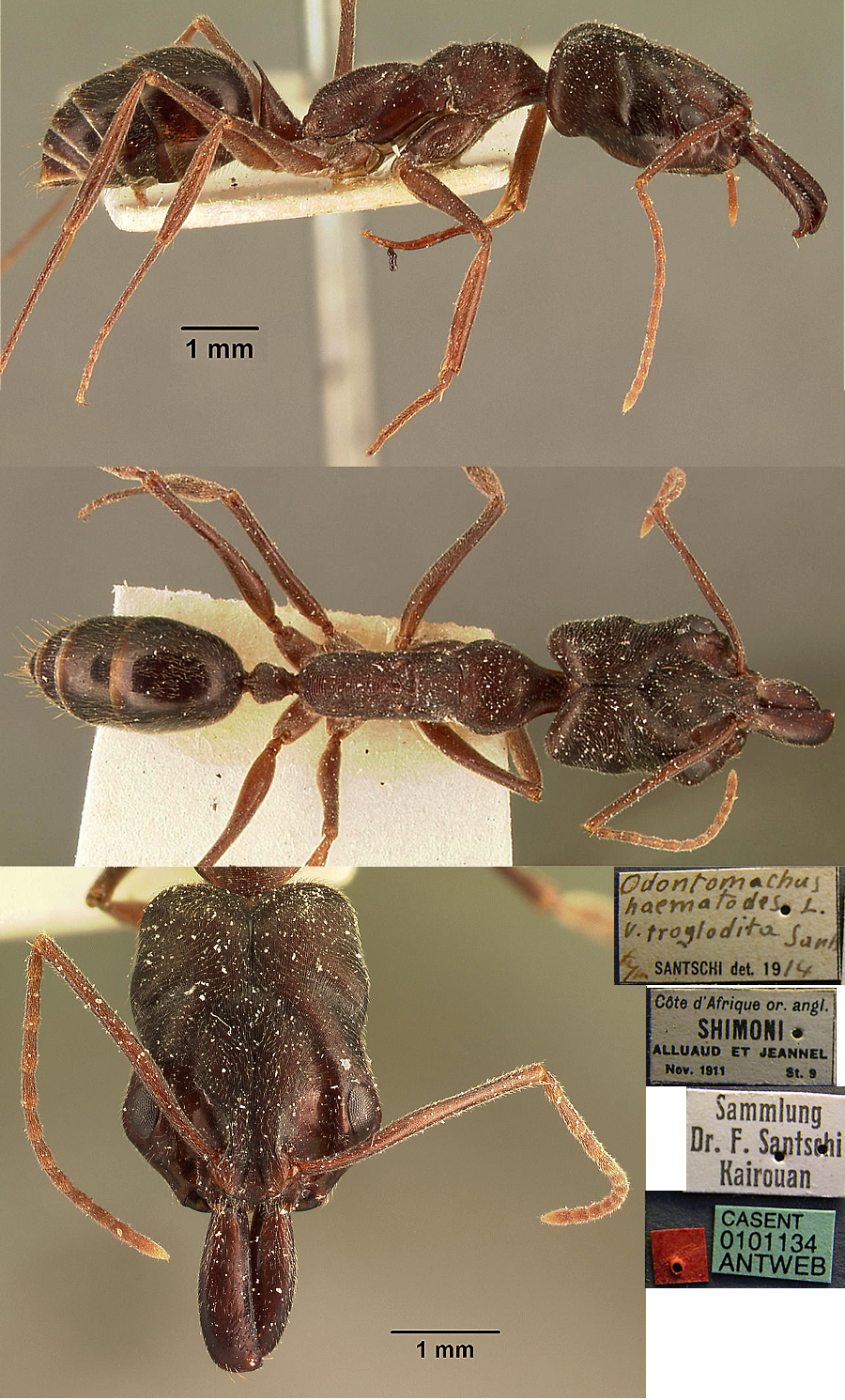 The photomontage of
the type worker is collated from http://www.antweb.org/specimen.do?name=casent0101134. The photomontage of
the type worker is collated from http://www.antweb.org/specimen.do?name=casent0101134.
|
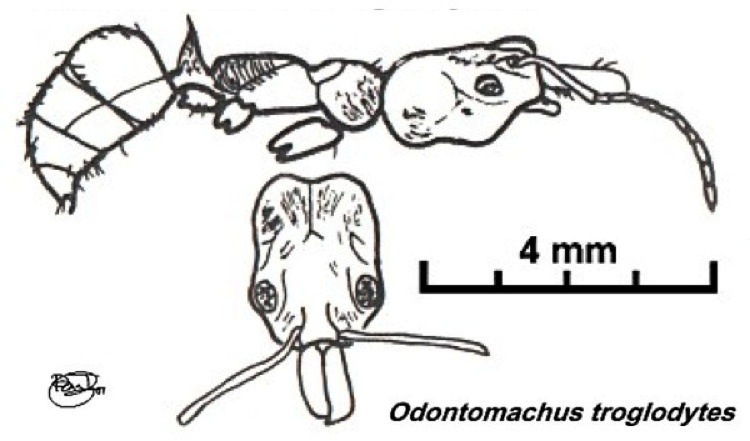 Nigeria specimens (Taylor 1976: 11) TL 10.0 mm,
HL 2.41, HW 2.03, SL 2.22 and PW 1.08 Nigeria specimens (Taylor 1976: 11) TL 10.0 mm,
HL 2.41, HW 2.03, SL 2.22 and PW 1.08
Overall colour very dark red-brown, shiny with sparse pubescence.
Alitrunk, especially pronotum and propodeum, with striated sculpture.
|
|
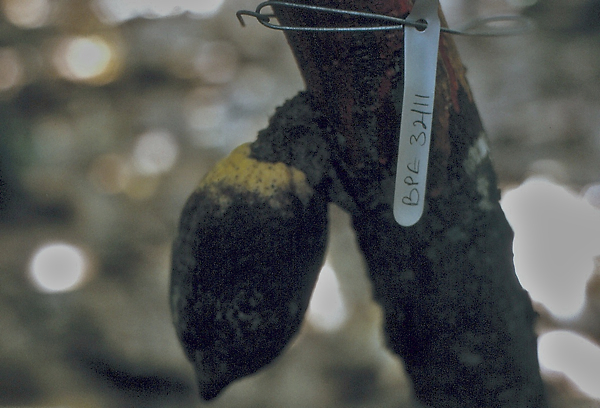 In Nigeria it is common in open or loosely
wooded areas. Nests in rotting wood on the ground or in tree stumps or
among the roots at the base of trees (right). It can be dominant
throughout the cocoa growing area, on 1.0-2.5% of cocoa trees but only
on lower trunk (Taylor, 1977; Taylor & Adedoyin, 1978). Earlier
from the Cocoa Research Institute of Nigeria, Idi Ayunre, by Booker
(perhaps on 1-2% of cocoa in collections from two cocoa blocks, W13/2
and W18/1, Booker, 1968). Often found ascending cocoa trees to tend
aphids and assorted other Homoptera; activity includes tent-building,
using coarse soil and debris. The tents (left) were frequently
associated with cocoa black pod infections (Taylor & Adedoyin,
1981). In Nigeria it is common in open or loosely
wooded areas. Nests in rotting wood on the ground or in tree stumps or
among the roots at the base of trees (right). It can be dominant
throughout the cocoa growing area, on 1.0-2.5% of cocoa trees but only
on lower trunk (Taylor, 1977; Taylor & Adedoyin, 1978). Earlier
from the Cocoa Research Institute of Nigeria, Idi Ayunre, by Booker
(perhaps on 1-2% of cocoa in collections from two cocoa blocks, W13/2
and W18/1, Booker, 1968). Often found ascending cocoa trees to tend
aphids and assorted other Homoptera; activity includes tent-building,
using coarse soil and debris. The tents (left) were frequently
associated with cocoa black pod infections (Taylor & Adedoyin,
1981).
|
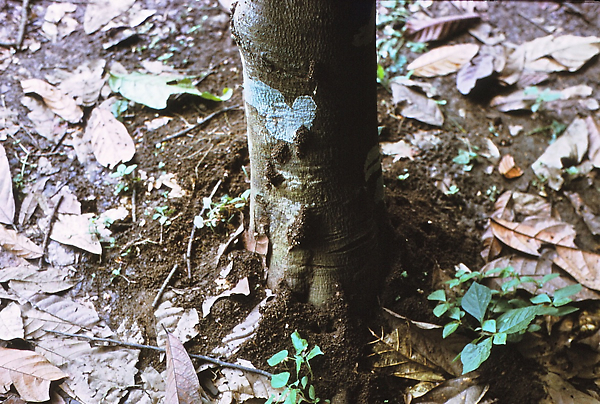 Widely named in earlier literature as Odontomachus
haematodus (L.), a forest ant of the lowland South American
tropical forests or O. haematodes. On the basis of
morphological characters there seems to be no easy way of
differentiating the African species from its South American cousin. Widely named in earlier literature as Odontomachus
haematodus (L.), a forest ant of the lowland South American
tropical forests or O. haematodes. On the basis of
morphological characters there seems to be no easy way of
differentiating the African species from its South American cousin.
Brown (1976a) gives almost no taxonomic information.
Wheeler (1922) listed many African findings of "haematoda", from
West Africa there was Senegal (Thiès, F. Silvestri), Guinea
(Kindia, F. Silvestri), Liberia (Junk River,
H. Brauns), Ivory Coast (Assinie, C, Alluaud), Ghana (Kitta,
H. Brauns; Aburi, F. Silvestri), Nigeria (Ibadan, Lagos,
Olokemeji, F. Silvestri; Oni Camp, W.A. Lamborn) and Cameroun (at
?, H. Brauns; Barombi, Freyer; Bibundi, Tessman; Yaundé, Zenker; Moliwe
Region, Conradt; and, Victoria, F. Silvestri).
General life history was described by Colombel (1972),
in Cameroun, where "a secondary habitat" involved nests in the
heads of palms. Colony size was some 300-1000 workers, larger in good
forest areas (see Brown, 1976b). Colony-specific nest marking was
reported by Déjean et al. (1984).
Described as occasionally found on Ghana cocoa
(as Odontomachus haematoda), probably as "chance migrants" from
leaf litter, by Strickland (1951a). Emergence of alates was principally
in September to November at CRIG, i.e. during the second wet season of
the year (Gibbs & Leston, 1970). Evans & Leston (1971), further
elaborated by Leston (1972), described its association with Homoptera
on cocoa, including the habit of building tents of soil and vegetable
matter, both thought to be the first reports of such behaviour in
Ponerines. They regarded it probably as of savannah origin, straying
into cocoa, particularly as it was not found in primary forest. Later
found in cocoa leaf litter and nesting in dead wood on the ground at
the Mampong Cemetery farm (Room, 1971); also from cocoa mistletoe
(Room, 1975); and a single worker was collected by pyrethrum knockdown
at Kade by Majer (1975, 1976b). Described as widespread (22 workers
from 7 sites, 1991-92) in leaf litter in the semi-deciduous forest zone
by Belshaw & Bolton (1994b).
In Guinea, Bernard (1952) noted that it (as Od.
haematoda) was curiously almost absent from the Mt. Nimba massif.
The only findings being from the Nimba, north-east forest litter, 4
workers (ix.1946, Villiers). The specimens were grey-black, with
reddish thorax, and TL 9.5 mm.
Hall, Cushman et al. (1998) described how
ant-tended homopterans indirectly benefit figs (genus Ficus)
across southern Africa (Madagascar, Malawi, South Africa, Zambia and
Zimbabwe). Among the ants was O. troglodytes found on 0.8% of
sampled fig trees.
|
Collection details and album links for specimens sent to
me are on Oxford
Museum specimens.
|
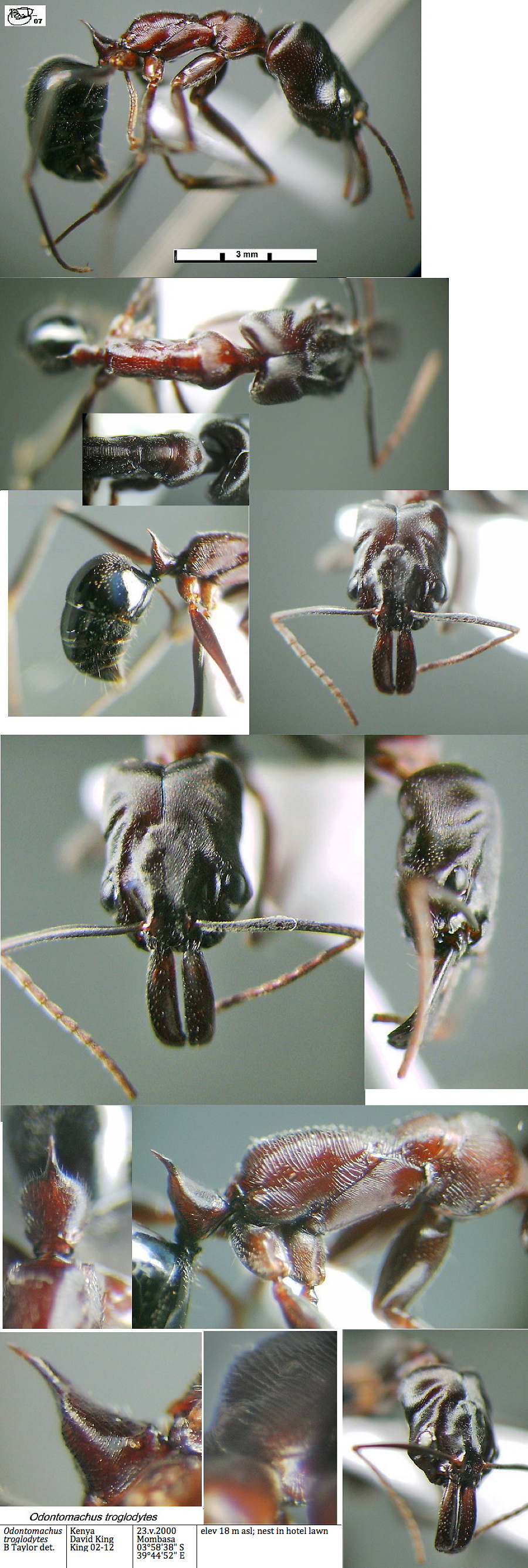 The photomontage is of
a worker from Kenya,
Mombasa, 03°58'S 39°45' E, elev 18 m.; nest in hotel lawn; 23.v.2000;
David King. The photomontage is of
a worker from Kenya,
Mombasa, 03°58'S 39°45' E, elev 18 m.; nest in hotel lawn; 23.v.2000;
David King.
|
 The photomontage is of
a worker from Gabon,
Pongara National Park; Pointe Wingombe, 00°19'336" N 09°19’102" E;
pitfalls under forest; Gabon 51, 20.vii.2006; collector Yves
Braet. The photomontage is of
a worker from Gabon,
Pongara National Park; Pointe Wingombe, 00°19'336" N 09°19’102" E;
pitfalls under forest; Gabon 51, 20.vii.2006; collector Yves
Braet.
|
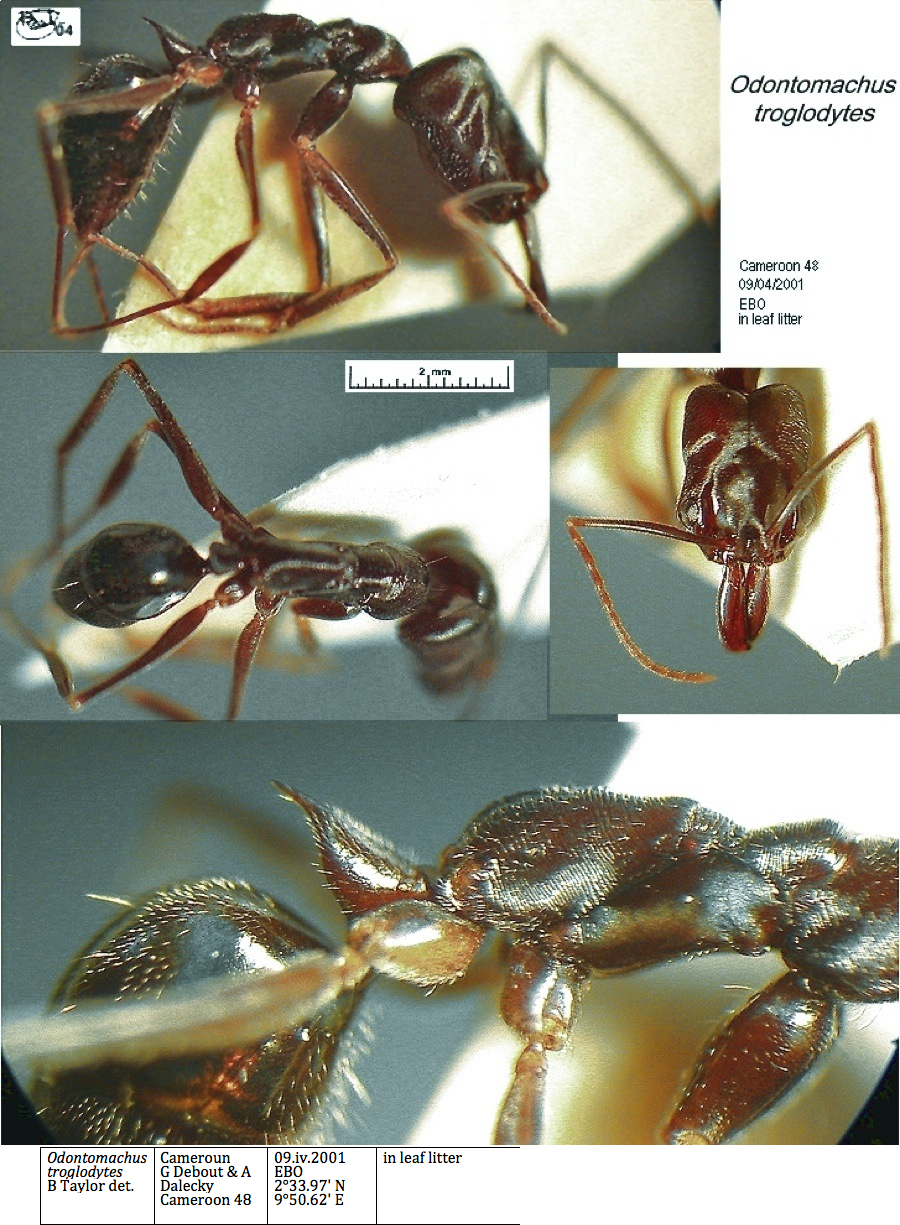 Photographed
worker collected in Cameroun, south-western tropical coastal
forest area between Edéa and Campo (McKey Wolbachia project
Cameroon 48) Photographed
worker collected in Cameroun, south-western tropical coastal
forest area between Edéa and Campo (McKey Wolbachia project
Cameroon 48)
|
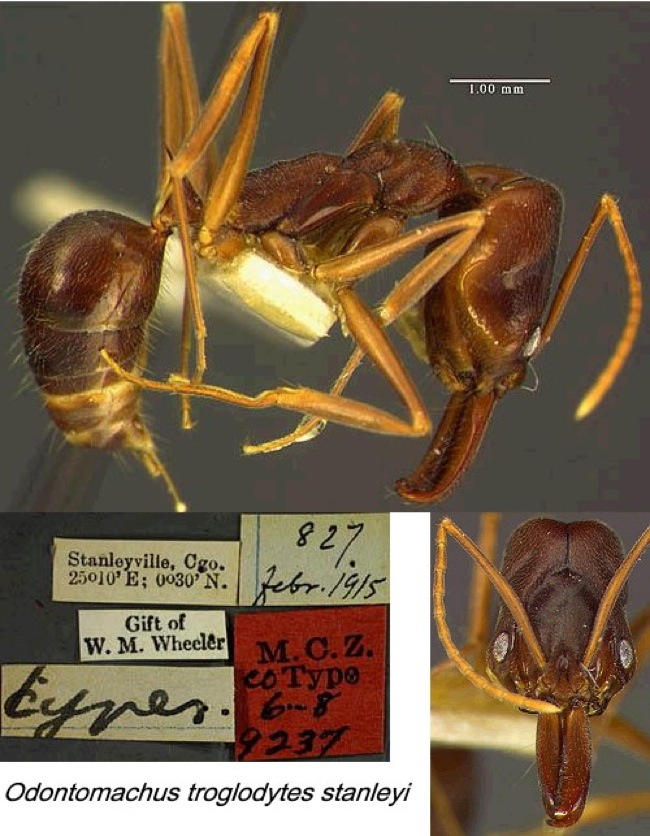 The
photomontage is of a cotype of Odontomachus
haematodus stanleyi from Zaïre. The original photographs,
together with enlarged images, are from the MCZ, Harvard University,
website at - MCZ link. The
photomontage is of a cotype of Odontomachus
haematodus stanleyi from Zaïre. The original photographs,
together with enlarged images, are from the MCZ, Harvard University,
website at - MCZ link.
|
 The photomontage is of
a queen from Botswana, collector David King (KIng 109). The photomontage is of
a queen from Botswana, collector David King (KIng 109).
|
 The photomontage is of
a male from the Central African Republic, collector P Annoyer (CAR OT1). The photomontage is of
a male from the Central African Republic, collector P Annoyer (CAR OT1).
|
|